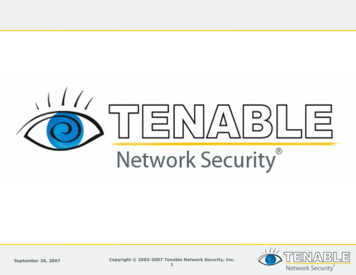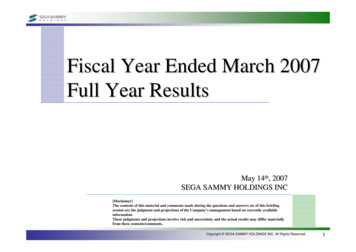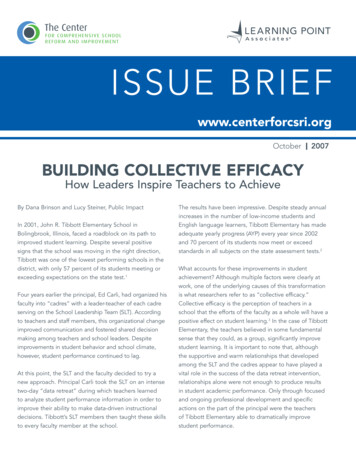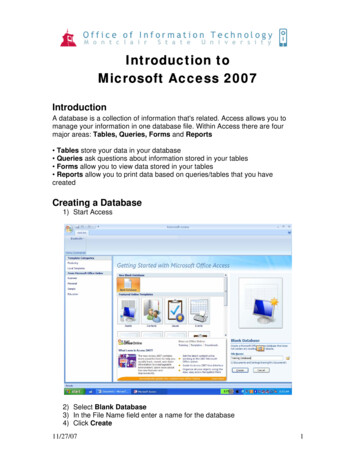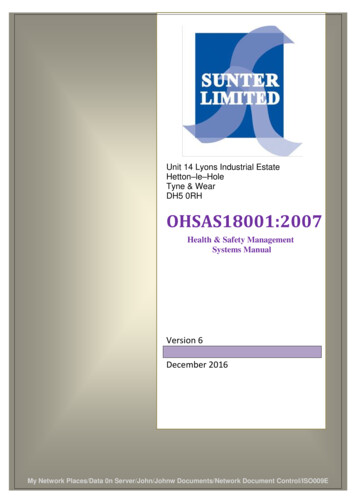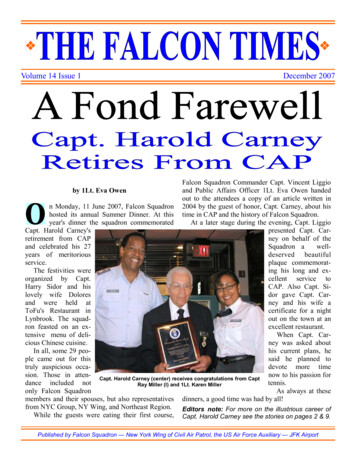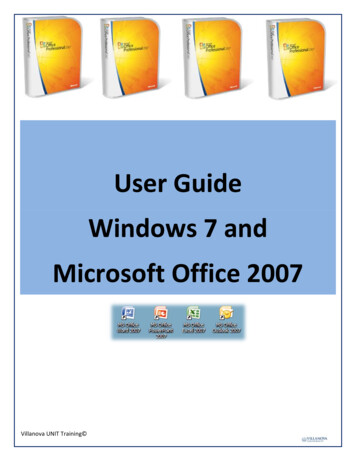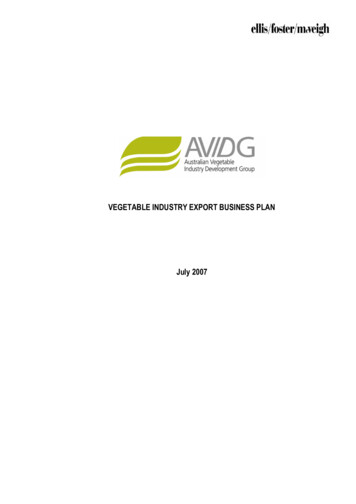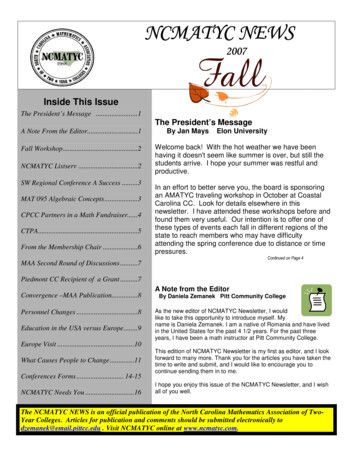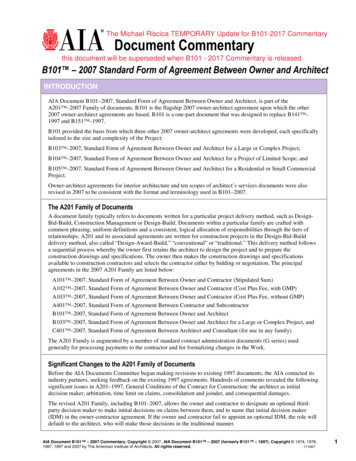
Transcription
The Michael Riscica TEMPORARY Update for B101-2017 CommentaryDocument Commentarythis document will be superseded when B101 - 2017 Commentary is releasedB101 – 2007 Standard Form of Agreement Between Owner and ArchitectINTRODUCTIONAIA Document B101–2007, Standard Form of Agreement Between Owner and Architect, is part of theA201 –2007 Family of documents. B101 is the flagship 2007 owner-architect agreement upon which the other2007 owner-architect agreements are based. B101 is a one-part document that was designed to replace B141 –1997 and B151 –1997.B101 provided the basis from which three other 2007 owner-architect agreements were developed, each specificallytailored to the size and complexity of the Project:B103 –2007, Standard Form of Agreement Between Owner and Architect for a Large or Complex Project;B104 –2007, Standard Form of Agreement Between Owner and Architect for a Project of Limited Scope; andB105 –2007, Standard Form of Agreement Between Owner and Architect for a Residential or Small CommercialProject.Owner-architect agreements for interior architecture and ten scopes of architect’s services documents were alsorevised in 2007 to be consistent with the format and terminology used in B101–2007.The A201 Family of DocumentsA document family typically refers to documents written for a particular project delivery method, such as DesignBid-Build, Construction Management or Design-Build. Documents within a particular family are crafted withcommon phrasing, uniform definitions and a consistent, logical allocation of responsibilities through the tiers ofrelationships. A201 and its associated agreements are written for construction projects in the Design-Bid-Builddelivery method, also called “Design-Award-Build,” “conventional” or “traditional.” This delivery method followsa sequential process whereby the owner first retains the architect to design the project and to prepare theconstruction drawings and specifications. The owner then makes the construction drawings and specificationsavailable to construction contractors and selects the contractor either by bidding or negotiation. The principalagreements in the 2007 A201 Family are listed below:A101 –2007, Standard Form of Agreement Between Owner and Contractor (Stipulated Sum)A102 –2007, Standard Form of Agreement Between Owner and Contractor (Cost Plus Fee, with GMP)A103 –2007, Standard Form of Agreement Between Owner and Contractor (Cost Plus Fee, without GMP)A401 –2007, Standard Form of Agreement Between Contractor and SubcontractorB101 –2007, Standard Form of Agreement Between Owner and ArchitectB103 –2007, Standard Form of Agreement Between Owner and Architect for a Large or Complex Project, andC401 –2007, Standard Form of Agreement Between Architect and Consultant (for use in any family)The A201 Family is augmented by a number of standard contract administration documents (G-series) usedgenerally for processing payments to the contractor and for formalizing changes in the Work.Significant Changes to the A201 Family of DocumentsBefore the AIA Documents Committee began making revisions to existing 1997 documents, the AIA contacted itsindustry partners, seeking feedback on the existing 1997 agreements. Hundreds of comments revealed the followingsignificant issues in A201–1997, General Conditions of the Contract for Construction: the architect as initialdecision maker, arbitration, time limit on claims, consolidation and joinder, and consequential damages.The revised A201 Family, including B101–2007, allows the owner and contractor to designate an optional thirdparty decision maker to make initial decisions on claims between them, and to name that initial decision maker(IDM) in the owner-contractor agreement. If the owner and contractor fail to appoint an optional IDM, the role willdefault to the architect, who will make those decisions in the traditional manner.AIA Document B101 – 2007 Commentary. Copyright 2007. AIA Document B101 – 2007 (formerly B151 – 1997). Copyright 1974, 1978,1987, 1997 and 2007 by The American Institute of Architects. All rights reserved.1116071
The revised A201 Family also eliminates mandatory arbitration, which AIA documents have required since 1888.Agreements in the revised A201 Family provide check boxes where the parties may choose arbitration, litigation, oranother method of binding dispute resolution for resolving disputes.In addition, the 2007 A201 Family of documents is less restrictive regarding consolidation of arbitration and thejoinder of third parties, when arbitration is the selected method of binding dispute resolution.Provisions relating to statutory limitation periods for filing binding dispute resolution proceedings weresubstantially revised in the 2007 documents. The waiver of consequential damages clause, added to the A201Family in 1997, remains in the 2007 family as a barrier to “runaway” claims.Changes to 2007 Owner-Architect AgreementsFor owner-architect agreements, the industry and AIA internal groups shared these concerns: B141–1997 two-partformat, phases versus services, basic services and additional services, errors and omissions insurance, standard ofcare, green design, the architect as initial decision maker (discussed above), ownership of instruments of service,and the requirement to design to the owner’s budget for the cost of the work. All of these issues were addressed inthe development of B101–2007.B101 FormatIn 1997, the AIA released its flagship owner-architect agreement B141–1997 as a two-part document. The AIArevised the format of B141 by separating the agreement into two parts: B141–1997 Part 1, the agreement terms, andB141–1997 Part 2, the scope of the architect’s services. The AIA made this change to recognize, in a veryprominent way, the change that had been taking place in the architecture profession over the previous ten years.Many architects found they could practice more successfully by developing specialties, such as by providinghistoric preservation studies and reports. These architects seldom needed an agreement to provide services for thedesign and construction of buildings; instead, they needed a contract form that would allow for a specialized scopeof services. By separating the agreement terms from the scope of services, the AIA allowed architects to achieveinfinite flexibility in contracting for their services.When revising B141–1997 for release in 2007, the AIA took a hard look at the success of the two-part agreementand found that while it served the interests of the specialist architect, it created undue complexity for the architectproviding traditional design and contract administration services. Those architects and their clients had gravitatedtoward using B151–1997, a one-part agreement for traditional services, modeled after B141–1987. Recognizing thevalidity of that choice, the AIA developed B101–2007, a one-part document that follows the format of B151–1997,but uses text copied and edited from both B141–1997 and B151–1997.B101–2007 consolidates and replaces B141–1997 and B151–1997. B101 sets forth the architect’s services duringfive phases: schematic design, design development, construction documents, bidding/negotiation, and constructioncontract administration. B101 returns to the concept of “basic” and “additional” services and explicitly sets forthbasic services in Article 3. Additional services, listed in Article 4, may be simply thought of as any service that isnot a basic service. As such, additional services may be included in the agreement when it is executed, or added asthe project proceeds.To provide an agreement for the specialist architect, or the architect who may initially provide services for a specialscope of work (e.g., a security evaluation) and then provide traditional design and contract administration services,the AIA divided the text of B101–2007 into two parts: the agreement portion (per B141–1997 Part 1), and theservices portion (per B141–1997 Part 2). These two new documents are numbered B102–2007 and B201–2007,respectively.Standard of CareB101–2007 Section 2.2 includes a statement of the standard of care pursuant to which the architect shall perform itsservices. In large part, this is an entirely new addition to the owner-architect agreements. B141–1997 and B151–1997 only contain a vague reference to a standard of care, noting that “[t]he Architect’s services shall be performedas expeditiously as is consistent with professional skill and care and the orderly progress of the Project.” While theclear implication from this language is that the architect’s services are subject to a standard of care, the 1997documents do not contain any statement as to what that standard of care is.AIA Document B101 – 2007 Commentary. Copyright 2007. AIA Document B101 – 2007 (formerly B151 – 1997). Copyright 1974, 1978,1987, 1997 and 2007 by The American Institute of Architects. All rights reserved.1116072
Generally speaking, like all professionals, an architect must perform its duties consistent with the degree of care andcompetence generally expected of a reasonably skilled member of the profession. This standard of care applies inany professional activity an architect undertakes, regardless of whether or not the standard of care is stated in thecontract for services. The AIA found, however, that parties often added standard of care language to contractsirrespective of this fact. The AIA also discovered that, in many instances, the general standard of care wasmisstated. The high occurrence of misstating the standard of care troubled the AIA because it could lead to a generalmisunderstanding as to the actual standard.Accordingly, the AIA saw fit to include a clear and explicit statement of the generally applicable standard of care inits 2007 revisions stating that the architect will perform its services consistent with that level of skill and careordinarily provided by architects practicing under the same or similar circumstances. It is true that from state to statethe applicable standard of care may be stated slightly differently, however, this definition is generally accuratenationwide. Additionally, the definition is sufficiently flexible to adapt to each state’s particular standard of care. Itis the AIA’s intent that B101–2007 will provide the owner with a better understanding of the common law standardof care for an architect. Practically speaking, however, the inclusion of this standard of care provision in the contractwill have essentially no impact on the nature of the architect’s services, as those services have always been subjectto a common law standard of care definition similar to that set forth in B101.Insurance RequirementsAnother new addition to the 2007 owner-architect agreements is a requirement that the architect maintain insurance.B101–2007 contains a provision requiring the parties to specify the types and limits of insurance the architect isrequired to maintain. Where those requirements exceed the types or levels of insurance the architect normallymaintains, the owner is required to reimburse the architect for the costs of obtaining such excess insurance.B141–1997 and B151–1997 contained a similar requirement that excess insurance the owner required the architectto obtain was a reimbursable expense; however, those documents did not contain an explicit duty on the part of thearchitect to maintain any minimum levels or types of insurance.Sustainable DesignThe AIA has adopted and stated a public policy that architects must be environmentally responsible in performingtheir services and must advocate for the sustainable use of Earth’s resources in the creation and operation of thebuilt environment in which we live.1 In furtherance of these goals, B101–2007 requires the architect, during theschematic design phase and as part of its basic services, to discuss with the owner the feasibility of incorporatingenvironmentally responsible design approaches into the project. Through this discussion, the owner and the architectare to reach an understanding with regard to the project’s overall requirements, and if and how environmentallyresponsible design will be incorporated into the design.The owner may require environmentally responsible design solutions that exceed the limit of the architect’s basicservices. That limit is set forth in Article 3 by requiring the architect, as part of its basic services, to considerenvironmentally responsible design alternatives, such as building orientation and material choices, in preparing aschematic design to the extent the alternatives are appropriate to the project and consistent with the owner’s statedprogram, schedule and budget. Therefore, if the owner requests extensive design alternatives such as unique systemdesigns, in-depth materials research, energy modeling, or LEED certification, the architect will provide thoseservices as an additional service for additional compensation.B101–2007, however, does not place the burden or duty of achieving environmentally responsible design solely onthe architect—that burden falls upon the owner and the architect together. In the end, owners decide the ultimatelevel of environmentally responsible design that will be incorporated into their buildings. The B101 provisions bringenvironmentally responsible design to the attention of the owner and the architect while the project’s specificrequirements are being developed. As such, B101 provides a platform for the architect to fulfill the AIA’s publicpolicy without imposing open-ended design requirements on the architect to make all buildings they designenvironmentally responsible.1AIA Board of Directors, AIA Directory of Public Policies and Position Statements, 2005. The American Institute of Architects http://www.aia.org/SiteObjects/files/Public Policy Directory revised 1205.pdf . (The AIA’s relevant public policy: “Thecreation and operation of the built environment require an investment of the earth’s resources. Architect
the AIA divided the text of B101–2007 into two parts: the agreement portion (per B141–1997 Part 1), and the services portion (per B141–1997 Part 2). These two new documents are numbered B102–2007 and B201–2007, respectively. Standard of Care
